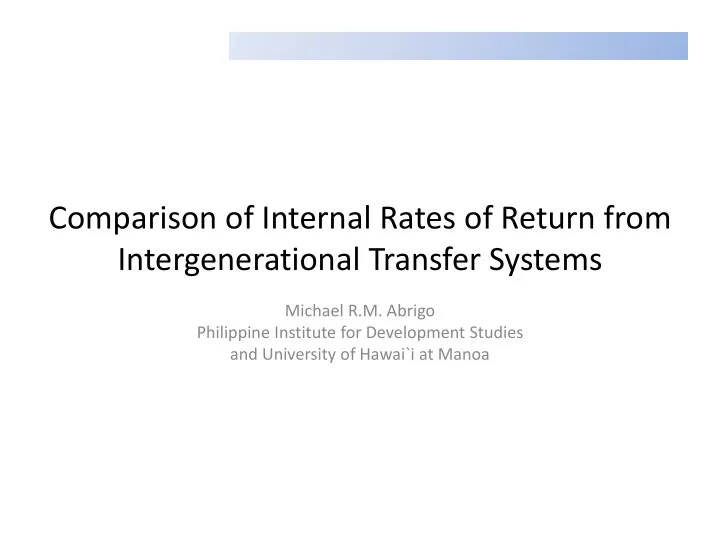

Comparison of Internal Rates of Return from Intergenerational Transfer Systems Michael R.M. Abrigo Philippine Institute for Development Studies and University of Hawai`i at Manoa
Background Labor income does not match consumption at every stage of the lifecycle
Background Labor income does not match consumption at every stage of the lifecycle Consumption and Labor Income Per Capita Age Profile: Philippines, 1999
Background Labor income does not match consumption at every stage of the lifecycle Consumption and Labor Surplus Income Per Capita Age Profile: Philippines, 1999 Deficit Deficit
Background Deficit should be financed somehow: transfers from surplus ages, draw from savings, etc. Consumption and Labor Surplus Income Per Capita Age Profile: Philippines, 1999 Deficit Deficit
Background Bottom line: Consumption is financed Consumption Financing: Philippines, 1999
Background Economies finance lifecycle deficit differently ARG HUN SWE 1/3 2/3 PER DEU Asset Public SVN Reallocation Transfers COL 2/3 JPN 1/3 USA CRI BRA CHL PHL KOR ESP IDN 1/3 2/3 IND ZAF THA CHN Private Transfers SEN
Question How do people from different economies choose how to finance the lifecycle deficit?
Objectives Describe intergenerational transfer systems Relate measure to theory
Literature Describe intergenerational transfer systems Lee Arrows: Lee (1994), Patxot, et. al. (2012) Transfer Wealth: Kotlikoff and Summers (1981) Bommier and Lee (2003), Lee and Mason (2011) Rate of Return: Auerbach and Lee (2011)
Literature Relate measure to theoretic predictions Test of motives: Lillard and Willis (1997) Private transfers: Lee and Donehower (2011)
Measuring Rate of Return Usual internal rate of return (IRR) not unique if net flows change sign more than once Limits application for characterizing intergenerational transfer systems Modified IRR does not share this weakness
Modified IRR Compares future value of inflows against present value of outflows � � � � � � � In steady state, interest rates are equal Assumed � and � equal 10 ‐ year bond rate
Data and Assumptions Lee, R., A. Mason and members of the NTA network (2014). Is low fertility really a problem? Population aging, dependency and consumption. Science , 346, 229 ‐ 234. Assumptions Age profiles represent expected lifecycle flows Returns to intergenerational transfers are uncorrelated with returns to assets
Are Transfer Systems Profitable? Yes: Computed mIRRs > 0 1.5 ARG Excess Return (%), Private Transfers IDN ZAF 1 CRI CHN SVN IND URY BRA .5 COL MEX THA SWETWNCHL HUN DEU USA KOR PHL JPN PER ESP 0 45° Excess return computed as -.5 survival ‐ weighted modified SEN internal rate of return less 0 1 2 3 10 ‐ year bond rate Excess Return (%), Public Transfers
Are We Close to Steady State? No? 1.5 ARG Excess Return (%), Private Transfers IDN ZAF 1 CRI CHN SVN IND URY BRA COL .5 MEX THA SWETWNCHL HUN USA DEU KOR PHL JPN PER ESP 0 45° Red lines are sample -.5 averages SEN 0 1 2 3 Excess Return (%), Public Transfers
Implications If actual � and � rates are higher than 10 ‐ year bond rates, then mIRR are lower bounds Non ‐ altruistic motives are possible since expected rates of return are positive
Do We Live in a Markowitz World? Non ‐ altruistic agents mix investment options to maximize expected returns subject to risks (Markowitz, 1952) Predicts that relationship between investment shares depends on rates of return and risks Assumed returns of intergenerational transfer systems are uncorrelated with asset returns
Do We Live in a Markowitz World? Maybe, probably not Senegal Uncorrelated Returns Spain 0.9 Correlation Hungary Japan Peru Mexico Slovenia Brazil South Korea South Africa Chile China Costa Rica Plot compares Markowitz ‐ Germany Thailand theoretical predicted ratio of Argentina Indonesia private to public transfer India Taiwan outflows against observed Uruguay ratio United States Philippines Colombia Sweden -10 -5 0 5 10 15 20 25 Distance from observed ratio of Private to Public Transfer Outflow (Percentage points)
Implications People are not perfectly self ‐ interested Altruism and institutional design can be accommodated to explain distribution of intergenerational transfers, although profit ‐ motive cannot be entirely ruled out
Summary Data rejects Markowitz problem Supports Fama and French (1992) People are not one dimensional Supports Lillard and Willis (1997)
(Thank you very much!) mmabrigo@gmail.com
Recommend
More recommend